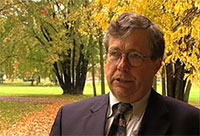Nov 23 2008
Cold, clean water from Lake Ontario has the potential to act as a natural coolant for buildings 30 miles away in Syracuse, N.Y., while reducing emissions of greenhouse gasses, substantially cutting energy costs, and aiding in the restoration of the long-polluted Onondaga Lake, according to a team of scientists from the SUNY College of Environmental Science and Forestry (ESF).
 Lake Ontario could provide a natural coolant for buildings in the region
Lake Ontario could provide a natural coolant for buildings in the region
Researchers from ESF are working on the effort, dubbed the Central New York Naturally Chilled Water Project, with an array of public agencies and corporate partners. They are conducting a feasibility study, funded by a $1.5 million federal appropriation, aimed at developing an innovative, alternative cooling system that could be used in the city of Syracuse, some 30 miles south of the easternmost Great Lake.
The environmentally friendly undertaking would pipe water from deep in Lake Ontario into Central New York’s Onondaga and Oswego counties. The lake water would provide a greenhouse gas-free cooling source that would reduce emissions and cut the amount of fossil fuels used to power mechanical chillers and coolers in regional private and public buildings. After being used, the oxygen-rich water would flow back through the smaller Onondaga Lake, adjacent to Syracuse, and then naturally return to Lake Ontario, closing the loop on the system.
Not only does the project stand to provide natural cooling to the region’s buildings, but the water, when deposited in Onondaga Lake, can aid in the cleanup of the lake, which has long been the site of remediation efforts after many years of industrial pollution. The water entering Onondaga Lake would be approximately 52 degrees, which is cooler than Onondaga Lake in the summer. This cooler, oxygen-rich water would help reduce mercury and other toxins, add oxygen naturally and enhance aquatic fisheries.
Since the feasibility study team began work, the group members have:
- Completed a draft of a comprehensive background report, summarizing the elements of a large-scale district cooling system and the history and current status of existing cooling systems in North America.
- Worked on developing a profile assessing the area’s energy demands and resources.
- Begun to evaluate the potential applications and benefits of a large-scale municipal cooling project in Central New York.
"This project provides significant economic and environmental benefits for our community," said U.S. Rep. James Walsh (NY-25), who appropriated the funds for the study. "By tapping cold, fresh water from Lake Ontario, running it through chillers to cool indoor air for downtown Syracuse or University Hill, and returning that oxygenated water back to the lake system untouched, we improve Onondaga Lake's water quality, create low cost, environmentally friendly chilled air, and reduce our region's reliance on fossil fuels."
ESF is partnering with Onondaga County and the county’s Metropolitan Water Board on the project. Also collaborating are Stearns and Wheler, Upstate Freshwater Institute, Syracuse Regional Planning and Development Board, Exponent, Gryphon International Engineers, Ecologic, and Hiscock and Barclay, LLP.
“The college is pleased to coordinate and implement this study to evaluate the economic and environmental benefits associated with the concept,” said ESF President Cornelius B. Murphy, Jr.